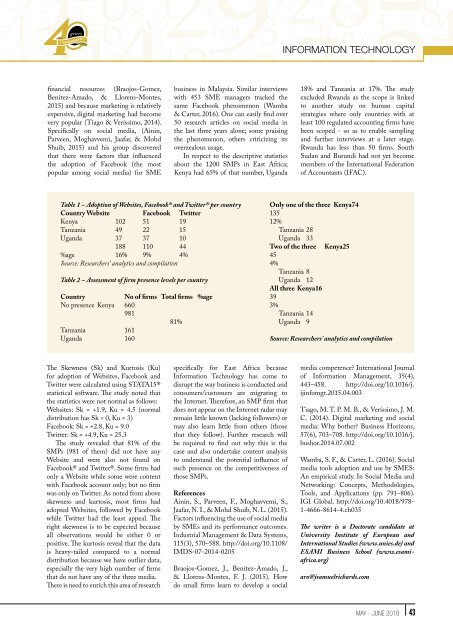May-June-issue
You also want an ePaper? Increase the reach of your titles
YUMPU automatically turns print PDFs into web optimized ePapers that Google loves.
INFORMATION TECHNOLOGY<br />
financial resources (Braojos-Gomez,<br />
Benitez-Amado, & Llorens-Montes,<br />
2015) and because marketing is relatively<br />
expensive, digital marketing had become<br />
very popular (Tiago & Veríssimo, 2014).<br />
Specifically on social media, (Ainin,<br />
Parveen, Moghavvemi, Jaafar, & Mohd<br />
Shuib, 2015) and his group discovered<br />
that there were factors that influenced<br />
the adoption of Facebook (the most<br />
popular among social media) for SME<br />
business in Malaysia. Similar interviews<br />
with 453 SME managers tracked the<br />
same Facebook phenomenon (Wamba<br />
& Carter, 2016). One can easily find over<br />
50 research articles on social media in<br />
the last three years alone; some praising<br />
the phenomenon, others criticizing its<br />
overzealous usage.<br />
In respect to the descriptive statistics<br />
about the 1200 SMPs in East Africa;<br />
Kenya had 65% of that number, Uganda<br />
18% and Tanzania at 17%. The study<br />
excluded Rwanda as the scope is linked<br />
to another study on human capital<br />
strategies where only countries with at<br />
least 100 regulated accounting firms have<br />
been scoped - so as to enable sampling<br />
and further interviews at a later stage.<br />
Rwanda has less than 50 firms. South<br />
Sudan and Burundi had not yet become<br />
members of the International Federation<br />
of Accountants (IFAC).<br />
Table 1 – Adoption of Websites, Facebook® and Twitter® per country<br />
Country Website Facebook Twitter<br />
Kenya 102 51 19<br />
Tanzania 49 22 15<br />
Uganda 37 37 10<br />
188 110 44<br />
%age 16% 9% 4%<br />
Source: Researchers’ analytics and compilation<br />
Table 2 – Assessment of firm presence levels per country<br />
Country<br />
No of firms Total firms %age<br />
No presence Kenya 660<br />
981<br />
81%<br />
Tanzania 161<br />
Uganda 160<br />
Only one of the three Kenya 74<br />
135<br />
12%<br />
Tanzania 28<br />
Uganda 33<br />
Two of the three Kenya 25<br />
45<br />
4%<br />
Tanzania 8<br />
Uganda 12<br />
All three Kenya 16<br />
39<br />
3%<br />
Tanzania 14<br />
Uganda 9<br />
Source: Researchers’ analytics and compilation<br />
The Skewness (Sk) and Kurtosis (Ku)<br />
for adoption of Websites, Facebook and<br />
Twitter were calculated using STATA15®<br />
statistical software. The study noted that<br />
the statistics were not normal as follows:<br />
Websites: Sk = +1.9, Ku = 4.5 (normal<br />
distribution has Sk = 0, Ku = 3)<br />
Facebook: Sk = +2.8, Ku = 9.0<br />
Twitter: Sk = +4.9, Ku = 25.3<br />
The study revealed that 81% of the<br />
SMPs (981 of them) did not have any<br />
Website and were also not found on<br />
Facebook® and Twitter®. Some firms had<br />
only a Website while some were content<br />
with Facebook account only; but no firm<br />
was only on Twitter. As noted from above<br />
skewness and kurtosis, most firms had<br />
adopted Websites, followed by Facebook<br />
while Twitter had the least appeal. The<br />
right skewness is to be expected because<br />
all observations would be either 0 or<br />
positive. The kurtosis reveal that the data<br />
is heavy-tailed compared to a normal<br />
distribution because we have outlier data,<br />
especially the very high number of firms<br />
that do not have any of the three media.<br />
There is need to enrich this area of research<br />
specifically for East Africa because<br />
Information Technology has come to<br />
disrupt the way business is conducted and<br />
consumers/customers are migrating to<br />
the Internet. Therefore, an SMP firm that<br />
does not appear on the Internet radar may<br />
remain little known (lacking followers) or<br />
may also learn little from others (those<br />
that they follow). Further research will<br />
be required to find out why this is the<br />
case and also undertake content analysis<br />
to understand the potential influence of<br />
such presence on the competitiveness of<br />
those SMPs.<br />
References<br />
Ainin, S., Parveen, F., Moghavvemi, S.,<br />
Jaafar, N. I., & Mohd Shuib, N. L. (2015).<br />
Factors influencing the use of social media<br />
by SMEs and its performance outcomes.<br />
Industrial Management & Data Systems,<br />
115(3), 570–588. http://doi.org/10.1108/<br />
IMDS-07-2014-0205<br />
Braojos-Gomez, J., Benitez-Amado, J.,<br />
& Llorens-Montes, F. J. (2015). How<br />
do small firms learn to develop a social<br />
media competence? International Journal<br />
of Information Management, 35(4),<br />
443–458. http://doi.org/10.1016/j.<br />
ijinfomgt.2015.04.003<br />
Tiago, M. T. P. M. B., & Veríssimo, J. M.<br />
C. (2014). Digital marketing and social<br />
media: Why bother? Business Horizons,<br />
57(6), 703–708. http://doi.org/10.1016/j.<br />
bushor.2014.07.002<br />
Wamba, S. F., & Carter, L. (2016). Social<br />
media tools adoption and use by SMES:<br />
An empirical study. In Social Media and<br />
Networking: Concepts, Methodologies,<br />
Tools, and Applications (pp. 791–806).<br />
IGI Global. http://doi.org/10.4018/978-<br />
1-4666-8614-4.ch035<br />
The writer is a Doctorate candidate at<br />
University Institute of European and<br />
International Studies (www.unies.de) and<br />
ESAMI Business School (www.esamiafrica.org)<br />
aro@jsamuelrichards.com<br />
MAY - JUNE 2018 43

















